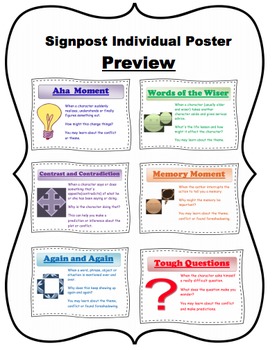

When my high school students read the allegory “Terrible Things” by Eve Bunting, I asked them to read the text three times. In this one lesson, students were reading the text for both understanding and author’s craft. We collected the post-its on the board and discussed the author’s word choice, including foreshadowing clues. For example, after reading and illustrating the scene from The Outsiders I describe above, I asked students to identify on small post-it notes diction the author used to build suspense. Sometimes I have students read the same text again with a new focus. I’m sure you can imagine that these eighth grade girls were very engaged with the reading and had strong opinions about the characters’ budding relationship. They picked up on some very subtle details that showed the characters falling in love. For example, while my eighth grade girls read a chapter of Elsewhere by Gabrielle Zevin, I asked them to collect examples that proved how Lizzie and Owen felt about each other. I love the perspective of Ponyboy underwater with his head in the fountain.īefore any independent reading time (which is almost every class), I set a very clear reading focus that is written on the board and ask students to highlight, write in the margins or on post-it notes, color code, or complete a graphic organizer/tracker (all active steps while reading). The text does not explicitly state that Johnny killed the Soc so the very close reading of it was critical for their understanding of the plot.

The scene is only one page, but I required students to pause four times to illustrate the events. Hinton, I asked them to illustrate the scene when the Socs try to drown Ponyboy and Johnny kills the Soc- a turning point in the novel that includes many important details that students might otherwise skim over. When my seventh graders were reading The Outsiders by S.E. Below is the text, a student’s illustration and, then, the actual painting by Manet. Without any prompting, he re-read the excerpt a third time to see why his drawing did not match the painting. For the excerpt below, the student initially drew a café scene and later realized that the actual painting was a portrait.

After they finished drawing, I showed them the actual paintings so they could assess their own close reading skills. In a chapter about the valuable artwork that was stolen, I asked students to re-read different short excerpts that described a painting and use these descriptions to draw the painting themselves.

My high school students are reading Ulrich Boser’s The Gardner Heist: The True Story of the World’s Largest Unsolved Art Theft, a book they chose because of their interest in art and the mafia. But, what does close reading look like? And how do you get a reluctant and struggling adolescent reader to read the same text more than once and pay close attention to the details? It is quite a challenge, but these go-to strategies have helped me enable my students, across grades 7-12, uncover the multiple meanings of text. With the shift to Common Core State Standards, there has been lots of talk of “close reading.” As a reading specialist, my responsibility is to help my students reach toward grade level with their reading skills, which most certainly involves having them read texts closely. 3 Go-To Close Reading Strategies by Abi Frost


 0 kommentar(er)
0 kommentar(er)
